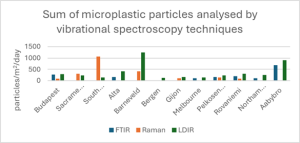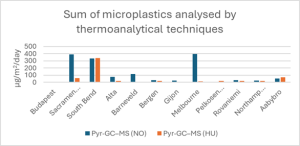Microplastic pollution, once considered primarily to be a marine problem, is now identified as a global air quality problem.
A groundbreaking international survey led by the Eurofins Environmental Test Microplastics Peer Group reveals a wide range of air pollution, with urban areas recording up to 1,300 microplastic particles per square meter per day.
These small plastic debris, less than 5 millimeters, are now known to travel through the atmosphere, transported by wind and air currents, and reach remote areas far from the city.
More concern is that the study detected microplastics in human lungs, blood and breast milk, raising urgent questions about the long-term health effects.
PlasticDustCloud Project
The PlasticDustCloud project is one of the most comprehensive and harmonious investigations of microplastics in the air to date.
Between July and August 2024, researchers collected samples from 12 sites on nine countries and three continents, including reference sites in cities such as Melbourne, Sacramento, Budapest, and Bergen, as well as rural Finland and Norway.
Sampling was performed using a standardized wet dry deposition method, including a funnel and glass bottle. This unified approach allowed scientists to compare results across regions, ensuring consistency and reliability directly.
What data reveals about microplastic contamination
This study found severe variations in microplastic deposition rates depending on site and detection techniques.
The results ranged from a median of 143 particles per square meter per day to 3,110 micrograms per square meter per day.
The key findings are as follows:
Deposition rate: Up to 1,300 particles/m² per day (spectroscopy) and 3.1 mg/m² per day (spectroscopy). Polymer Composition: Dominated by polyethylene (PE) and polypropylene (PP), reflecting the global plastic production trends. Particle size: Most particles are less than 100 µm, small enough to enter the human respiratory system. Additional source: Tire wear particles were detected at levels up to 304 µg/m² per day, highlighting the role of road traffic.
Interestingly, even adjacent sampling points can show significant differences, highlighting the heterogeneous distribution of aerial microplastics and the challenge of accurate measurement.
Advanced Testing Methods
To ensure robust results, samples were analyzed at Eurofins’ cutting-edge laboratories using a set of complementary techniques.
Vibration spectroscopy such as FTIR, LDIR, and Raman was adopted along with thermal analysis techniques such as pyrolysis-GC/MS and TED-GC/MS.
Although a rigorous quality assurance protocol was applied throughout, this study emphasizes that a single analytical method cannot capture the overall picture of microplastic pollution.


Calling for tuned microplastic action
The discovery of microplastic pollution in the air adds a new dimension to the challenges of the global environment.
Unlike ocean and soil contamination, microplastics in the air can be inhaled directly, putting humans at potential health risks. The ability to carry dangerous chemicals is of particular concern.
As cities expand and plastic production continues to grow, experts warn that air exposure could become an increasingly important public health issue.
The PlasticDustCloud project highlights the urgent need for standardized global monitoring protocols, and better track, compare and ultimately reduce this invisible pollution.
As evidence increases, the message is clear. Addressing microplastic pollution requires urgent, coordinated action before it escapes into the air, as the problem is already in the ocean.
Source link

